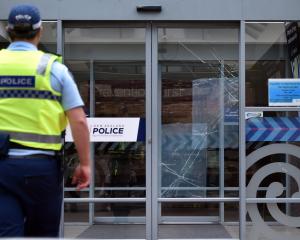
Tekapo businessman Anthony Tosswill was already grappling with public opposition to his plans for the 17-storey hotel and apartment tower opposite the Dunedin Town Hall.
As a resource consent hearing resumed yesterday, he was soon also facing calls to revise his designs again, even as a legal challenge stopped him from explaining how he could do it.
Yesterday’s session began with a warning from hearings panel chairman Andrew Noone, who told Mr Tosswill’s team the project faced "challenges" in its bid for resource consent.
Mr Tosswill had previously insisted the design was non-negotiable, before changes - including an irregular finish to the building’s towers at rooftop height - were made public last week.
The revisions dropped the hotel’s lobby lower to the street, even as its towers were "stepped" and its central core remained the same height.
Hotel architect Thom Craig said the change aimed to improve the hotel’s connection with the street, but was also a "gesture" to opponents worried about the building’s height.
It was expected to reduce mid-winter shading of the Octagon by 15%-20%, the hearing was told.
However, Mr Noone told Mr Tosswill’s team when it came to issuing a consent, the revised design still "poses some challenges to be able to get over the line".
The changes were "quite modest" and amounted to "a relatively minor reduction" in the building’s height, he said.
"Is there an appetite to try and further address the effects that have been identified by experts and submitters in relation to that visual dominance?"
Mr Craig, responding to questions, said further changes were possible.
That could include excavating a second extra level of underground car parking, to create more room to lower the building and reinstate a flush rooftop finish.
That would depend on ground conditions, Mr Tosswill’s requirements and the cost, but "those are all things we can look at", Mr Craig said.
"It can be fine-tuned," he said.
However, as Mr Craig prepared to outline further changes in more detail, he was stopped by a challenge from lawyer Lauren Semple, representing Millennium & Copthorne Hotels, which owns the neighbouring Kingsgate Hotel.
Ms Semple argued the changes would lack the supporting information required, risked prejudicing those who might want to have a fresh say on the changes, and could create "a perception of bias".
It was also difficult to assess the effects of any changes "on the fly", meaning negative impacts could be overlooked, she warned.
"There does have to be a point at which the pencil is put down and we understand what design the applicant is substituting for the applied-for building.
"I think we are close to that line."
The challenge prompted Mr Noone to call a short break while the panel took legal advice, and he emerged soon after to uphold Ms Semple’s concerns.
The panel would not allow fresh hotel plans to be presented, as that would require the hearing to be adjourned and fresh consultation on the changes, he said.
Instead, the panel, if it granted consent, could impose a condition reducing the hotel’s maximum height by four storeys, Mr Noone suggested.
That would be in keeping with an earlier recommendation by Garth Falconer, the independent urban design consultant advising the panel, which was already part of the public process, Mr Noone said.
It would be up to Mr Page to indicate, in his right of reply today, whether the approach was acceptable.
Mr Falconer, in his response to evidence yesterday, also reiterated the need for further changes.
The hotel could be "a game-changer" for Dunedin, but such a large proposal "will always struggle", he said.
The building’s size and lack of mitigation were concerns, while shading of the Octagon "has to be viewed as unacceptable", he said.
A four-storey reduction would help address those concerns, and he recommended Mr Tosswill "resubmit plans that directly respond to the stated concerns of height".
The consultants had also been unable to agree on acceptable design solutions, despite meeting last week to try to hammer out their differences.
While Mr Craig defended the design, and Mr Falconer called for a height reduction, Graeme McIndoe, an urban design consultant appearing for Millennium & Copthorne, argued the building was irredeemable.
"Taking four floors off would not make this building acceptable.
"It’s still a massively large contrasting building."
The hearing concludes today.











